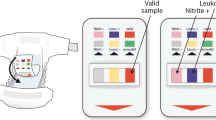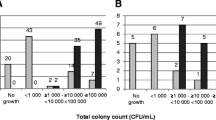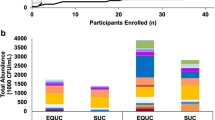Abstract
The purpose of this study was to evaluate whether community-dwelling women can reliably identify infected urine samples. A convenience sample of 25 women judged six urine samples. Of these, two were normal, two contained culture-proven infections, and two were intentionally abnormal because of ingestion of asparagus or vitamins. The women decided if each sample was infected based on its color, clarity, and odor. For the two normal samples, 56 and 96% women correctly identified them. Of the two samples positive for infection, women were correct 80 and 100% of the time. Of the two samples designed to be abnormal, women were correct in 92 and 64% of their evaluations. Using the 150 total evaluations of urine samples, the sensitivity was 90%, and the specificity was 77%. Based on this small sample, community-dwelling women can detect infected samples of urine. However, women should still be screened for factors that might have distorted normal urine.
Similar content being viewed by others
References
Foxman B (2003) Epidemiology of urinary tract infections: incidence, morbidity and economic costs. Dis Mon 49(2):53–70
Midthun SJ, Paur R, Lindseth G (2004) Urinary tract infections: does the smell really tell? J Gerontol Nurs 30(6):4–9
Mehnert-Kay SA (2005) Diagnosis and management of uncomplicated urinary tract infections. Am Fam Phys 72(3):451–456
Bent S, Saint S (2002) The optimal use of diagnostic testing in women with acute, uncomplicated cystitis. Am J Med 113(1A):20S–28S
Gupta K, Hooton TM, Roberts PL, Stamm WE (2001) Patient-initiated treatment of uncomplicated recurrent urinary tract infections in young women. Ann Intern Med 135:9–16
Saint S, Scholes D, Fihn SD, Farrell RG, Stamm WE (1999) The effectiveness of a clinical practice guideline for the management of presumed uncomplicated urinary tract infection in women. Am J Med 106:636–641
Barry HC, Hickner J, Ebell MH, Ettenhofer T (2001) A randomized controlled trial of telephone management of suspected urinary tract infections in women. J Fam Pract 50(7):589–594
Simerville JA, Maxted WC, Pahira JJ (2005) Urinalysis: a comprehensive review. Am Fam Phys 71:1153–1162
Midthun SJ (2004) Criteria for urinary tract infection in the elderly: variables that challenge nursing assessment. Urol Nurs 24(3):157–169
Struthers S, Scanlon J, Parker K, Goddard J, Hallett R (2003) Parental reporting of smelly urine and urinary tract infections. Arch Dis Child 88:250–252
Walter JS, Sacks J, Othman R, Rankin AZ, Nemchausky B, Chintam R et al (2002) A database of self-reported secondary medical problems among VA spinal-cord injury patients: Its role in clinical care and management. J Rehabil Res Dev 39(1):53–61
Phillips G, Fleming LW, Khan I, Stewart WK (1992) Urine transparency as an index of absence of infection. Br J Urol 70:191–195
Acknowledgment
This was an unfunded study. None of the authors has a conflict of interest.
Author information
Authors and Affiliations
Corresponding author
Additional information
Presented in poster form at the American Urogynecology Society, Palm Springs, CA, October 2006.
Rights and permissions
About this article
Cite this article
Schimpf, M.O., Murdza, M., O’Sullivan, D.M. et al. Can community-dwelling women reliably identify infected urine?. Int Urogynecol J 18, 1357–1361 (2007). https://doi.org/10.1007/s00192-007-0343-7
Received:
Accepted:
Published:
Issue Date:
DOI: https://doi.org/10.1007/s00192-007-0343-7




